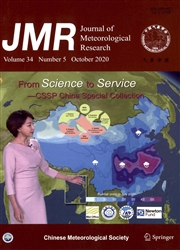A New Equatorial Oscillation Index for Better Describing ENSO and Westerly Wind Bursts
作者:Yunhao SHI,Jingzhi SU
摘要:An Equatorial Oscillation Index(EOI) is defined, based on the zonal gradient of sea surface pressure between the western Pacific and eastern Pacific along the equator, to describe the distribution of wind and pressure within the equatorial Pacific. The EOI has a stronger correlation with the Ni?o3.4 sea surface temperature anomaly(SSTA), as well as with westerly/easterly wind bursts(WWBs/EWBs), showing a superiority over the Southern Oscillation Index(SOI). In general, the EOI is consistent with the SOI, both of which reflect large-scale sea level pressure oscillations. However, when there are inconsistent SSTAs between the equator and subtropical regions, the SOI may contrast with the EOI due to the reverse changes in sea level pressure in the subtropical regions. As a result, the SOI fails to match the pattern of El Ni?o, while the EOI can still match it well. Hence, the EOI can better describe the variability of the Ni?o3.4 SSTA and WWBs/EWBs. The correlation between the SOI and Ni?o3.4 SSTA falls to its minimum in May, due to the large one-month changes of sea level pressure from April to May in the subtropical southern Pacific, which may be related to the spring predictability barrier(SPB). The newly defined EOI may be helpful for monitoring El Ni?o–Southern Oscillation(ENSO) and predicting ENSO.
发文机构:Chinese Academy of Meteorological Sciences College of Earth and Planetary Sciences
关键词:EquatorialOscillation(EO)SouthernOscillation(SO)westerlywindbursts(WWBs)EOFENSOpredictionspringpredictabilitybarrier(SPB)
分类号: P73[天文地球—海洋科学]
- Major Scientific Achievements of the First China–Japan Cooperative GAME/HUBEX Experiment: A Historical Review
- Identifying and Quantifying Pixel-Level Uncertainty among Major Satellite Derived Global Land Cover Products
- A Multivariable Approach for Estimating Soil Moisture from Microwave Radiation Imager(MWRI)
- Spatial Distribution and Temporal Trend Characteristics of Agro-Climatic Resources and Extreme Climate Events during the Soybean Growing Season in Northeast China from 1981 to 2017
- Bias Analysis and Correction of Ground Surface Temperature Observations across China
- Research Progress on Estimation of the Atmospheric Boundary Layer Height
- Joint Effect of East Asia-Pacific and Eurasian Teleconnections on the Summer Precipitation in North Asia
- Increasing Trend of Summertime Synoptic Wave Train Activity over the Western North Pacific since 1950
- Spatiotemporal Drought Assessment over Sahelian Countries from 1985 to 2015
- Climate Sensitivity and Feedbacks of BCC-CSM to Idealized CO2 Forcing from CMIP5 to CMIP6


